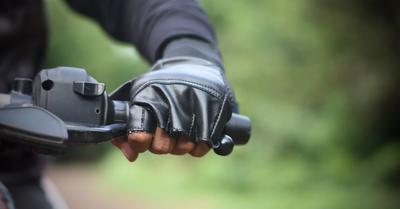What Does It Mean To Break In My Tires?
Suppose you go to the showroom floor of a motorcycle dealership and look at a couple of bikes with zero miles on them. You might notice that the tires look slightly different than those with more miles under them.
New tires will appear glossy. This shiny appearance is because most tire manufacturers use release agents on the tires to ensure they come cleanly out of the mold. While this is great for the manufacturer, what this means for you is that the rubber doesn’t have quite as much grip as it does without this agent on them.
Breaking in, sometimes called running in or conditioning, refers to getting the slippery release agent coating off the new tires. Usually, the break-in period is referred to as the number of miles needed to ensure that the release agent layer is entirely off the tires and the rubber has its maximum grip.
You may see people taking a belt sander to their tires, weaving side to side, or washing the tires with a harsh chemical bath, but I’m here to tell you those things are not only not necessary but potentially dangerous.
Why Do I Need To Break In My Tires?
Your motorcycle’s tires are the only interface your bike has with the ground. Just a tiny strip of rubber keeps your bike upright and moving in the intended direction. As you ride your tires, you wear them in and start to understand their characteristics and limits.
Brand new tires ride differently than ones that have had some time with the asphalt. Even if you replaced your tires with the same make and model as the ones that just came off, a new set of rubber is going to be a little different.
The shiny coating on the tires from release agents can interfere with how grippy the rubber is. This lack of traction will catch you by surprise if you’re not anticipating it. Tires that aren’t broken in should not be ridden fast or pushed in the corners because they can more easily lose traction and cause you to lay down your bike.
Breaking in your tires is also important to ensure they last as long as possible and wear evenly. When your tires are appropriately conditioned, you won’t have low spots or areas of uneven tread wear.
Broken-in tires have maximum traction and behave predictably when pushed to their limits. Riding your bike hard before your tires are ready can spell disaster. Traction affects all aspects of your motorcycle, from cornering to braking.
Breaking In Your Motorcycle Tires
Now that we know what breaking in your tires means and why you need to do it, it’s time to answer the all-important question: how do you break in your motorcycle tires? I will also clear up a few myths regarding breaking in your tires.
Properly breaking in your tires can save you from an unexpected accident. You must properly break in your tires before you start to push their limits.
Myths About Breaking In Motorcycle Tires
Let’s start with a couple of misconceptions about breaking your tires in. You’ll see people online talking about using a belt sander or a chemical wash to eliminate the release agent layer. While good-intentioned, these methods could damage the tire and make it even more dangerous to ride.
Chemicals can interact with the rubber compound and degrade the quality of the rubber, making it unsafe or causing it to wear out prematurely. Scuffing up the tires with sandpaper can cause low spots in the tire if you sand off too much of the rubber. It is also a lot of work to take sandpaper to your entire tire when there is a much easier way to do it: just going for a ride.
Heat Is Your Friend
The best and only surefire way to break in your tires is with heat. If you’ve seen motorcycles at the race track, you may notice they have tire warmers wrapped around their tires. These tire warmers help to break up the release agent on the new tires and make them ready for the track.
Not everyone has access to tire warmers, of course. For the everyday person, the best way to break in your tires is to go for a long ride. The general rule is to put 100 miles on your tires before pushing their limits. This works because as you ride, your tires start to warm up from the friction generated by contact with the pavement.
There are a few things to be mindful of to break in your tires properly. First, you want to ensure the tires are correctly mounted, balanced, and inflated. This ensures that the wheel rolls true and the heat is dispersed evenly.
To help speed up the process, plan your break-in ride during warm weather is best. If it’s cold outside, the tires won’t warm as much as they do on a hot day. You also need to be mindful not to ride new tires in conditions that can further compromise traction, so avoid riding on rainy days.
While breaking in your tires, ensure your tires are properly balanced and inflated, and that your bike is appropriately loaded. Doing so will provide a safe and even tire break-in. After your first 100 or so miles, start pushing your tires gradually. Soon your tires will have the maximum traction.















